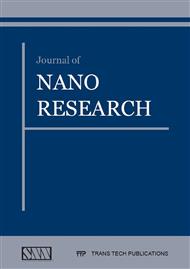[1]
C. Stecksen-Blicks, G. Renfors, N.D. Oscarson, F. Bergstrand, S. Twetman, Caries-preventive effectiveness of a fluoride varnish: a randomized controlled trial in adolescents with fixed orthodontic appliances, Caries Res. 41 (2007) 455-459.
DOI: 10.1159/000107932
Google Scholar
[2]
B. Ogaard, E. Larsson, T. Henriksson, D. Birkhed, S.E. Bishara, Effects of combined application of antimicrobial and fluoride varnishes in orthodontic patients, Am. J. Orthod. Dentofac. 120 (2001) 28-35.
DOI: 10.1067/mod.2001.114644
Google Scholar
[3]
S. Oh, K.S. Moon, J.H. Moon, J.M. Bae, S.H. Jin, Visible Light Irradiation-Mediated Drug Elution Activity of Nitrogen-Doped TiO2 Nanotubes, J. Nanomat. (2013).
DOI: 10.1155/2013/802318
Google Scholar
[4]
S. Sun, W. Wang, L. Zhang, L. Zhou, W. Yin, M. Shang, Visible light-induced efficient contaminant removal by Bi5O7I, Environ. Sci. Technol. 43 (2009) 2005-(2010).
DOI: 10.1021/es8032814
Google Scholar
[5]
D.Y. Wu, M.C. Long, W.M. Cai, C. Chen, Y.H. Wu, Low temperature hydrothermal synthesis of N-doped TiO2 photocatalyst with high visible-light activity, J. Alloy. Compd. 502 (2010) 289-294.
DOI: 10.1016/j.jallcom.2010.04.189
Google Scholar
[6]
C. Chen, M.C. Long, H. Zeng, W.M. Cai, B.X. Zhou, J.Y. Zhang, Y.H. Wu, D.W. Ding, D.Y. Wu, Preparation, characterization and visible-light activity of carbon modified TiO2 with two kinds of carbonaceous species, J. Mol. Catal. A-Chem. 314 (2009).
DOI: 10.1016/j.molcata.2009.08.014
Google Scholar
[7]
F.H. Tian, C.B. Liu, DFT description on electronic structure and optical absorption properties of anionic S-doped anatase TiO2, J. Phys. Chem. B. 110 (2006) 17866-17871.
DOI: 10.1021/jp0635462
Google Scholar
[8]
C. Di Valentin, G. Pacchioni, A. Selloni, S. Livraghi, E. Giamello, Characterization of paramagnetic species in N-doped TiO2 powders by EPR spectroscopy and DFT calculations, J. Phys. Chem. B. 109 (2005) 11414-11419.
DOI: 10.1021/jp051756t
Google Scholar
[9]
S. Livraghi, M.R. Chierotti, E. Giamello, G. Magnacca, M.C. Paganini, G. Cappelletti, C.L. Bianchi, Nitrogen-Doped Titanium Dioxide Active in Photocatalytic Reactions with Visible Light: A Multi-Technique Characterization of Differently Prepared Materials, J. Phys. Chem. C. 112 (2008).
DOI: 10.1021/jp803806s
Google Scholar
[10]
F. Peng, L.F. Cai, L. Huang, H. Yu, H.J. Wang, Preparation of nitrogen-doped titanium dioxide with visible-light photocatalytic activity using a facile hydrothermal method, J. Phys. Chem. Solids. 69 (2008) 1657-1664.
DOI: 10.1016/j.jpcs.2007.12.003
Google Scholar
[11]
L. Boyanova, G. Gergova, R. Nikolov, S. Derejian, E. Lazarova, N. Katsarov, I. Mitov, Z. Krastev, Activity of Bulgarian propolis against 94 Helicobacter pylori strains in vitro by agar-well diffusion, agar dilution and disc diffusion methods, J. Med. Microbiol. 54 (2005).
DOI: 10.1099/jmm.0.45880-0
Google Scholar
[12]
ISO7405, Dentistry - Evaluation of biocompatibility of medical devices used in dentistry, Geneva, Switzerland (2008).
Google Scholar
[13]
X.B. Chen, C. Burda, Photoelectron spectroscopic investigation of nitrogen-doped titania nanoparticles, J. Phys. Chem. B. 108 (2004) 15446-15449.
DOI: 10.1021/jp0469160
Google Scholar
[14]
M.S. Wong, H.P. Chou, T.S. Yang, Reactively sputtered N-doped titanium oxide films as visible-light photocatalyst, Thin Solid Films. 494 (2006) 244-249.
DOI: 10.1016/j.tsf.2005.08.132
Google Scholar
[15]
S. Sakthivel, M. Janczarek, H. Kisch, Visible light activity and photoelectrochemical properties of nitrogen-doped TiO2, J. Phys. Chem. B. 108 (2004) 19384-19387.
DOI: 10.1021/jp046857q
Google Scholar


